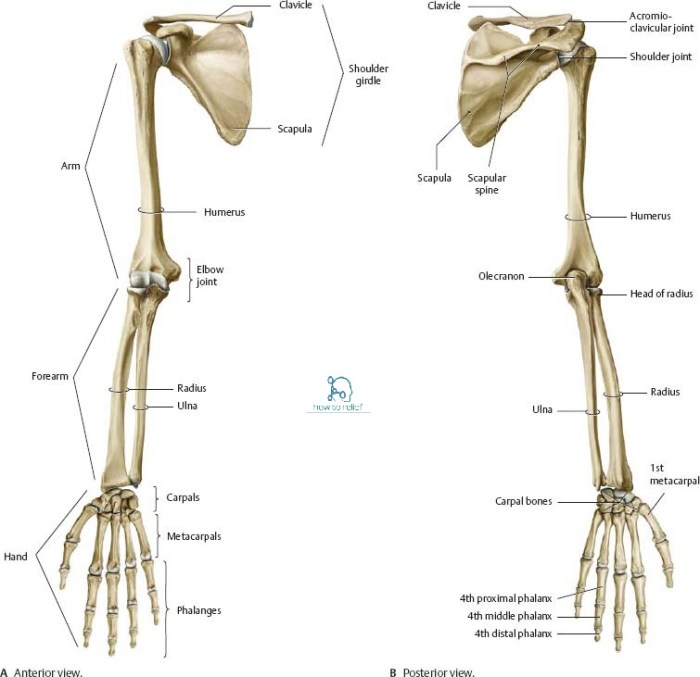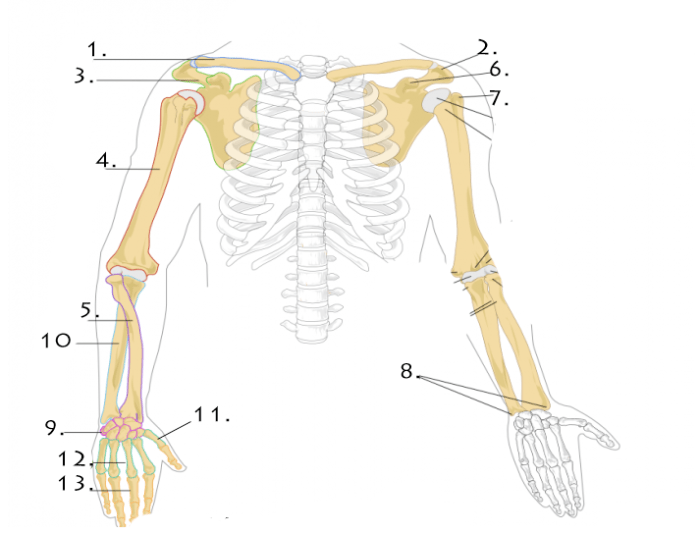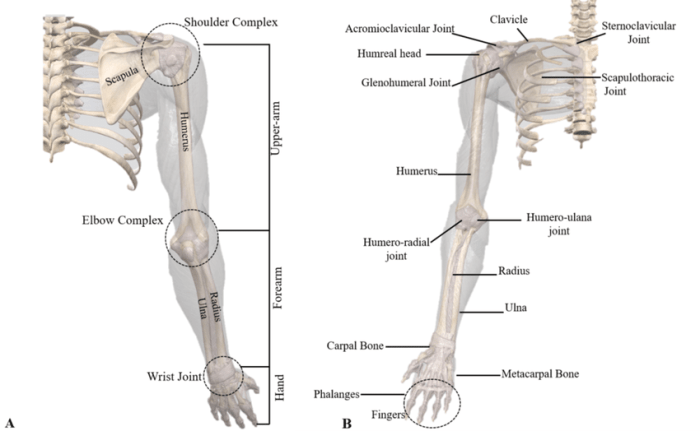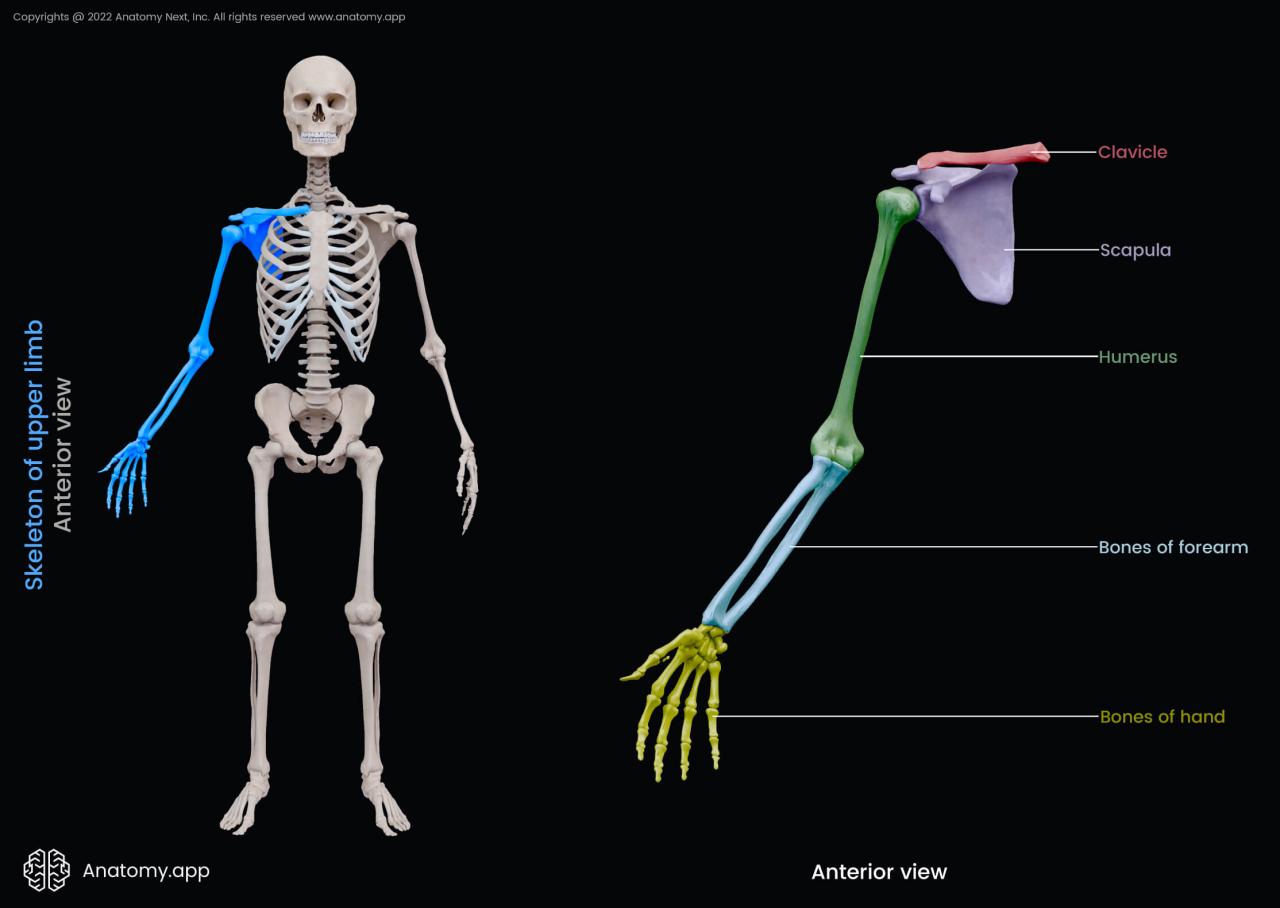Prepare to dive into the fascinating world of bones of upper limb quiz, where we’ll uncover the intricacies of our upper body’s skeletal framework. From the clavicle to the phalanges, we’ll delve into the names, locations, and functions of these remarkable structures, unraveling the secrets of human anatomy.
As we journey through this skeletal adventure, we’ll explore the different types of bones, discover the joints that connect them, and delve into the muscles, blood supply, and innervation that bring them to life. Along the way, we’ll uncover the clinical applications of this knowledge, showcasing its importance in diagnosing and treating upper limb injuries and disorders.
Bones of the Upper Limb
The upper limb consists of the bones of the arm, forearm, and hand. The arm bone is called the humerus, and it extends from the shoulder to the elbow. The forearm bones are the radius and ulna, which extend from the elbow to the wrist.
The hand bones consist of the carpals, metacarpals, and phalanges. The carpals are eight small bones that form the wrist, the metacarpals are five long bones that form the palm of the hand, and the phalanges are the fourteen bones that form the fingers and thumb.
Anatomical Positions of the Upper Limb Bones
The anatomical positions of the upper limb bones are described using the following terms:
- Proximal: Nearer to the trunk of the body
- Distal: Farther from the trunk of the body
- Medial: Towards the midline of the body
- Lateral: Away from the midline of the body
- Anterior: Towards the front of the body
- Posterior: Towards the back of the body
For example, the humerus is proximal to the radius and ulna, and the radius is lateral to the ulna.
Table of Upper Limb Bones
The following table lists the bones of the upper limb, their locations, and their functions:
| Bone | Location | Function |
|---|---|---|
| Humerus | Arm | Provides support and allows for movement of the arm |
| Radius | Forearm | Allows for rotation of the forearm and hand |
| Ulna | Forearm | Provides support and stability to the forearm |
| Carpals | Wrist | Form the wrist joint and allow for movement of the hand |
| Metacarpals | Palm of the hand | Form the palm of the hand and allow for movement of the fingers |
| Phalanges | Fingers and thumb | Form the fingers and thumb and allow for movement of the fingers and thumb |
Types of Upper Limb Bones

The upper limb consists of three major segments: the arm, the forearm, and the hand. Each segment is made up of different types of bones, including long bones, short bones, and flat bones.
Long bones are the most common type of bone in the upper limb. They are characterized by their length, which is greater than their width. Long bones provide support and movement, and they are found in the arm (humerus), forearm (radius and ulna), and hand (metacarpals and phalanges).
Short bones are cube-shaped and provide stability and support. They are found in the wrist (carpals) and the ankle (tarsals).
Flat bones are thin and provide protection. They are found in the shoulder (scapula) and the pelvis (hip bone).
Unique Characteristics and Functions
Each type of bone has unique characteristics and functions. Long bones are strong and lightweight, which makes them ideal for supporting the weight of the body and providing movement. Short bones are strong and stable, which makes them ideal for providing support and stability to joints.
Flat bones are thin and flexible, which makes them ideal for protecting vital organs.
Examples of Upper Limb Bones
Here are some examples of upper limb bones that belong to each type:
- Long bones:humerus, radius, ulna, metacarpals, phalanges
- Short bones:carpals
- Flat bones:scapula
Joints of the Upper Limb

The upper limb is a complex and mobile structure that allows for a wide range of movements. These movements are made possible by the presence of several joints that connect the bones of the upper limb.
There are three major joints in the upper limb: the shoulder joint, the elbow joint, and the wrist joint. Each of these joints has a unique structure and function, allowing for different types of movements.
Types of Joints in the Upper Limb
There are three main types of joints in the upper limb: ball-and-socket joints, hinge joints, and pivot joints.
- Ball-and-socket jointsallow for a wide range of movements, including flexion, extension, abduction, adduction, and rotation.
- Hinge jointsallow for flexion and extension only.
- Pivot jointsallow for rotation only.
Movements Allowed by Each Type of Joint in the Upper Limb
The type of joint present in the upper limb determines the types of movements that are possible.
- Ball-and-socket joints, such as the shoulder joint, allow for the widest range of movements. These movements include flexion, extension, abduction, adduction, and rotation.
- Hinge joints, such as the elbow joint, allow for flexion and extension only. These movements are essential for activities such as reaching and grasping.
- Pivot joints, such as the joint between the radius and ulna, allow for rotation only. This movement is essential for activities such as turning the palm of the hand up or down.
Muscles of the Upper Limb: Bones Of Upper Limb Quiz

The upper limb consists of several muscles that work together to perform various movements. These muscles are located in the shoulder, arm, forearm, and hand. They are innervated by nerves from the brachial plexus.
Major Muscles of the Upper Limb
- Shoulder:Deltoid, supraspinatus, infraspinatus, teres minor, subscapularis
- Arm:Biceps brachii, triceps brachii, brachialis
- Forearm:Flexor carpi radialis, flexor carpi ulnaris, extensor carpi radialis, extensor carpi ulnaris, pronator teres, supinator
- Hand:Thenar muscles (abductor pollicis brevis, opponens pollicis, flexor pollicis brevis), hypothenar muscles (abductor digiti minimi, flexor digiti minimi brevis, opponens digiti minimi), interosseous muscles, lumbricals, dorsal interosseous muscles, palmar interosseous muscles
Each muscle has specific actions and functions, enabling the upper limb to perform a wide range of movements, including flexion, extension, abduction, adduction, rotation, and supination.
Table of Muscles of the Upper Limb
| Muscle | Location | Action | Innervation |
|---|---|---|---|
| Deltoid | Shoulder | Abduction, flexion, extension | Axillary nerve |
| Supraspinatus | Shoulder | Abduction | Suprascapular nerve |
| Infraspinatus | Shoulder | Lateral rotation | Suprascapular nerve |
| Teres minor | Shoulder | Lateral rotation | Axillary nerve |
| Subscapularis | Shoulder | Medial rotation | Subscapular nerves |
| Biceps brachii | Arm | Flexion | Musculocutaneous nerve |
| Triceps brachii | Arm | Extension | Radial nerve |
| Brachialis | Arm | Flexion | Musculocutaneous nerve |
| Flexor carpi radialis | Forearm | Flexion | Median nerve |
| Flexor carpi ulnaris | Forearm | Flexion, ulnar deviation | Ulnar nerve |
| Extensor carpi radialis | Forearm | Extension | Radial nerve |
| Extensor carpi ulnaris | Forearm | Extension, ulnar deviation | Radial nerve |
| Pronator teres | Forearm | Pronation | Median nerve |
| Supinator | Forearm | Supination | Radial nerve |
| Thenar muscles | Hand | Movements of the thumb | Median nerve, ulnar nerve |
| Hypothenar muscles | Hand | Movements of the little finger | Ulnar nerve |
| Interosseous muscles | Hand | Abduction, adduction | Ulnar nerve, median nerve |
| Lumbricals | Hand | Flexion | Median nerve, ulnar nerve |
| Dorsal interosseous muscles | Hand | Abduction | Radial nerve |
| Palmar interosseous muscles | Hand | Adduction | Ulnar nerve, median nerve |
Blood Supply to the Upper Limb
The upper limb receives its blood supply from several major arteries and veins. These vessels ensure that oxygenated blood reaches the tissues and organs of the arm, hand, and fingers, and that deoxygenated blood is returned to the heart.
Arteries
The main arteries that supply blood to the upper limb are the subclavian artery and the axillary artery. The subclavian artery branches off from the aorta, the main artery that carries blood from the heart to the body. The subclavian artery travels through the neck and into the armpit, where it becomes the axillary artery.
The axillary artery gives off several branches, including the brachial artery, which supplies blood to the arm. The brachial artery divides into the radial and ulnar arteries at the elbow. The radial artery supplies blood to the thumb, index finger, middle finger, and ring finger.
After a quick revision of the bones of the upper limb, let’s take a break with a classic tale. The timeless story of Beauty and the Beast reminds us of the power of love and acceptance. But don’t forget, when we return to our studies, we’ll delve deeper into the intricate structure of the upper limb.
The ulnar artery supplies blood to the little finger and the medial side of the hand.
Veins, Bones of upper limb quiz
The main veins that drain blood from the upper limb are the subclavian vein and the axillary vein. The subclavian vein receives blood from the brachial vein, which drains blood from the arm. The subclavian vein travels through the neck and into the chest, where it joins with the internal jugular vein to form the brachiocephalic vein.
The brachiocephalic vein then joins with the superior vena cava, which carries blood from the upper body to the heart.
Clinical Significance
The blood supply to the upper limb is essential for the proper function of the arm, hand, and fingers. Injuries or disorders that affect the blood supply can lead to serious consequences, such as ischemia (lack of blood flow) or gangrene (tissue death).
Some common conditions that can affect the blood supply to the upper limb include:
- Arterial thrombosis: A blood clot that forms in an artery, blocking blood flow.
- Embolism: A blood clot or other material that travels through the bloodstream and blocks an artery.
- Aneurysm: A weakened area in the wall of an artery that bulges outward.
- Vasculitis: Inflammation of the blood vessels.
Prompt diagnosis and treatment of these conditions is essential to prevent serious complications.
Innervation of the Upper Limb

The innervation of the upper limb is complex, involving multiple nerves that originate from the brachial plexus. The brachial plexus is a network of nerves that forms in the neck and extends into the axilla (armpit) and upper limb.The brachial plexus gives rise to several branches that innervate different regions of the upper limb.
These branches include:
Musculocutaneous Nerve
- Innervates the biceps brachii, brachialis, and coracobrachialis muscles.
- Provides sensory innervation to the lateral forearm and hand.
Median Nerve
- Innervates the pronator teres, flexor carpi radialis, palmaris longus, and flexor digitorum superficialis muscles.
- Provides sensory innervation to the palmar surface of the thumb, index finger, middle finger, and lateral half of the ring finger.
Ulnar Nerve
- Innervates the flexor carpi ulnaris, flexor digitorum profundus, and intrinsic hand muscles.
- Provides sensory innervation to the palmar surface of the medial half of the ring finger and little finger.
Radial Nerve
- Innervates the triceps brachii, brachioradialis, and extensor muscles of the forearm and hand.
- Provides sensory innervation to the posterior surface of the arm, forearm, and hand.
Axillary Nerve
- Innervates the deltoid and teres minor muscles.
- Provides sensory innervation to the skin over the shoulder and lateral upper arm.
Suprascapular Nerve
- Innervates the supraspinatus and infraspinatus muscles.
- Provides sensory innervation to the skin over the shoulder.
Clinical Significance
Understanding the innervation of the upper limb is crucial for diagnosing and treating various injuries and disorders. Damage to any of these nerves can result in sensory or motor deficits in the corresponding regions of the upper limb. For example, damage to the median nerve can lead to carpal tunnel syndrome, which causes numbness and weakness in the thumb, index, and middle fingers.
Similarly, damage to the ulnar nerve can result in ulnar nerve entrapment, which causes weakness and numbness in the little finger and medial half of the ring finger.
Clinical Applications

Knowledge of the anatomy of the upper limb is essential for healthcare professionals to diagnose and treat injuries and disorders effectively. This knowledge includes understanding the bones, joints, muscles, blood supply, and innervation of the upper limb.
Diagnosis of Upper Limb Injuries and Disorders
A thorough understanding of the anatomy of the upper limb allows healthcare professionals to accurately diagnose injuries and disorders. For example, a doctor may use X-rays to identify a broken bone, or they may perform a physical examination to assess the range of motion in a joint.
By understanding the normal anatomy of the upper limb, healthcare professionals can identify deviations from normal that may indicate an injury or disorder.
Treatment of Upper Limb Injuries and Disorders
Knowledge of the anatomy of the upper limb is also essential for the effective treatment of injuries and disorders. For example, a doctor may need to know the location of the muscles in the forearm in order to perform surgery to repair a tendon.
Or, they may need to know the course of the blood vessels in the upper arm in order to insert an IV line.
Importance for Healthcare Professionals
Understanding the anatomy of the upper limb is essential for healthcare professionals in a variety of settings. This knowledge is used in the diagnosis and treatment of injuries and disorders, as well as in the development of new treatments and technologies.
By having a strong foundation in upper limb anatomy, healthcare professionals can provide the best possible care for their patients.
FAQ Compilation
What is the longest bone in the upper limb?
Humerus
How many bones are there in the forearm?
Two: Radius and Ulna
What type of joint is the shoulder joint?
Ball-and-socket joint
Which nerve innervates the muscles of the hand?
Median nerve
What is the function of the clavicle?
Connects the sternum to the shoulder joint, providing support and mobility